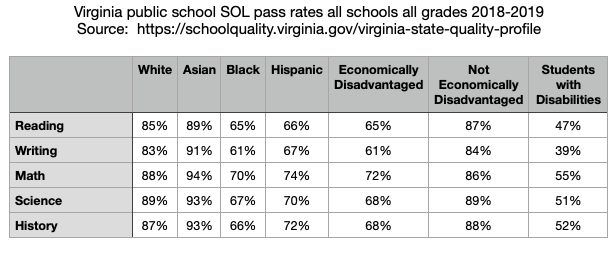by James C. Sherlock
I have some very good news about public education at the K-12 level. Just not yet in Virginia.
But first a baseline of Virginia statistics to get our heads straight.
The bad news. I offer below a chart of Virginia public school Spring 2019 SOL pass rates (all schools all grades) for different subgroups of students. The 2018-2019 school year was the last before COVID. The last “no excuses” year.

The statewide student populations of those subgroups in 2018-19 were:
- White: 624,738 – (projecting results to all grades, 106,000 were not writing at grade level)
- Asian: 92,122
- Black: 286,032 – over 100,000 of these kids could not read at grade level).
- Hispanic: 208,739 – 54,272 could not perform math at grade level)
- Economically Disadvantaged: 520,827 – 182,289 were not reading at grade level
- Not Economically Disadvantaged: 769,940 – 107,791 could not perform math at grade level
- Students with Disabilities: 170,750 – 90,497 were not reading at grade level
Many schools, of course, have far worse results. Those schools are not providing appropriate learning environments and are not teaching these kids properly. Not even close.
There is no shortage of “experts” with unworkable, even counterproductive ideas of how to fix this. Such people are thickly congregated in graduate schools of education.
Perhaps we should look to people who have actually succeeded. Just a thought.
The good news. I have never received as much inquiry about anything as I have about my series on Loudoun County Public Schools and their documented failures to teach literacy and math to minority children.
Friends and acquaintances from all over the state have contacted me directly. Including, encouragingly, a member of the Fairfax County NAACP.
They have many perspectives, but a common thread is that they want to know how Success Academy (SA) charter management organization, with 47 schools in New York City, achieves such spectacular results. The kids they educate are overwhelmingly poor and minority (94%).
I will let SA speak for itself.
An introduction. For an orientation, see the page “Learning fueled by wonder.”
Elementary School. The online overview of the Success Academy blueprints for their elementary schools provides an important introduction to school design and values and the pedagogy. It offers the keys to SA successes.
SA also publishes online Introductory Guides to Literacy Instruction for grades kindergarten through 4. They include videos of many of the lessons being taught in Success Academy classrooms. I recommend them to teachers in public, private and home schools.
Middle School. The blueprints for SA middle schools are equally fascinating. I find the discussion of Special Education at SA in the school design section to be particularly illuminating. The results:
- On the most recent state exams, Scholars with disabilities at Success Academy outpaced the New York City average for students without disabilities in English Language Arts (ELA) (77 percent versus 56 percent) and dramatically outperformed in math (95 percent versus 53 percent).
The pedagogy section of the middle school blueprint offers classroom video examples of SA approaches to middle school literacy, math, electives, computer science, science, history and field studies. See especially the video on parental investment.
The field studies leverage NYC’s unique assets, but the rest of the blueprint is replicable.
High School. Blueprints for High School has a different format. It starts with School Design, but moves to Reinventing High School and College Access and Persistence.
Virtual Tours. First-rate documentary tours of elementary, middle and high school settings.
Family orientation. SA’s upcoming events list includes two online events for prospective parents. They are good opportunities to see how the system presents itself to families. You can register at the links if interested.
- Success Academy Williamsburg Prospective Parent Virtual Info Session/Tour November 30, 2021, 5:30 pm
- Success Academy Prospect Heights – Prospective Family Virtual Info Session December 1, 2021, 5:30 pm
Educator Portals. The resources aimed directly at educators include the Education Institute, the source of some of the links above, and the Robertson Center. The Robertson Center invites educators from across the country to online workshops, training, events and leadership development opportunities — all offered free of charge.
Bottom line. It is unalloyed good news that a system of public schools has demonstrated how to educate poor minority children to thrive so remarkably in school and in life.
I hope that Virginia public and private schools can learn from Success Academy and apply their methods. I also hope we can attract that organization to Virginia.
There are perhaps 200,000 kids in the Commonwealth in dire need of their teaching methods. Please send this to everyone you think might be interested in helping them.


